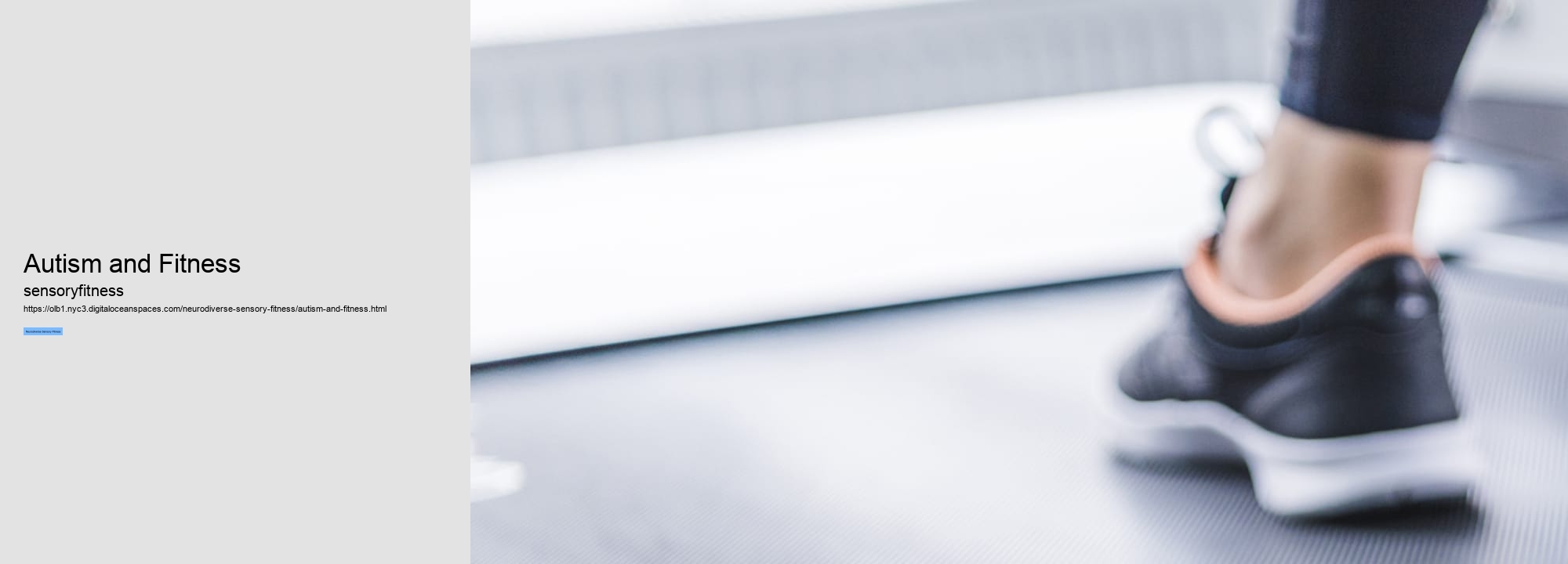

Overall, neurodiverse sensory fitness plays a crucial role in supporting the holistic well-being of individuals with neurodiverse conditions. By incorporating physical activity and sensory experiences into their daily routines, they can improve their physical health, emotional regulation, social skills, and overall quality of life. It is important to recognize the diverse needs of individuals with different neurological profiles and provide them with tailored fitness programs that cater to their unique strengths and challenges. What are some effective exercises for improving sensory fitness in neurodiverse individuals?
Sensory exercises can help enhance awareness, coordination, and regulation of sensory input, leading to improved focus, attention, and emotional regulation. There are several effective exercises that can be incorporated into a daily routine to support sensory development in individuals with neurodiversity. One beneficial exercise is deep breathing or diaphragmatic breathing.
This practice can help calm the nervous system, reduce stress levels, and improve overall relaxation. Deep breathing exercises can be especially helpful for individuals who experience sensory overload or heightened anxiety. Another effective exercise for improving sensory fitness is progressive muscle relaxation.
Progressive muscle relaxation can help increase body awareness and promote a sense of calmness and comfort. Additionally, yoga and mindfulness practices can be highly beneficial for enhancing sensory fitness in neurodiverse individuals. Yoga combines physical postures with breathwork and meditation to promote balance, flexibility, strength, and mindfulness.
Mindfulness practices encourage present-moment awareness and non-judgmental acceptance of thoughts, emotions, and sensations. These practices can help individuals with neurodiversity develop greater self-awareness, emotional regulation skills, and resilience. Sensory integration activities such as swinging gently on a swing set or using a therapy ball for balance exercises can also support sensory development in neurodiverse individuals. These activities provide opportunities to engage the vestibular system (responsible for balance) and proprioceptive system (responsible for body awareness), which can improve coordination and spatial orientation. Incorporating nature walks or outdoor play into daily routines can further enhance sensory fitness by providing exposure to natural stimuli such as sunlight, fresh air, textures, sounds, and smells. Engaging with nature can help individuals with neurodiversity connect with their senses in a meaningful way while promoting physical activity and cognitive stimulation.
By prioritizing self-care practices that enhance body awareness, relaxation, mindfulness, balance, coordination,and engagement with the environment , it is possible to promote holistic well-being among those with diverse neurological profiles . What role does sensory integration play in promoting overall wellness for neurodiverse individuals? Sensory integration plays a crucial role in promoting overall wellness for neurodiverse individuals. Our senses are constantly bombarded with stimuli from the environment, and for those with neurodivergent conditions such as autism, ADHD, or sensory processing disorder, these sensory inputs can be overwhelming and challenging to process. When an individual's sensory system is not functioning efficiently, it can lead to difficulties in regulating emotions, behaviors, and attention.
Sensory integration therapy aims to help individuals organize and interpret sensory information more effectively, ultimately leading to improved overall well-being. By engaging in sensory integration activities such as swinging, brushing, weighted blankets, or deep pressure massage, individuals with neurodiverse conditions can learn to better regulate their responses to sensory stimuli. This can result in reduced anxiety levels, improved focus and attention, enhanced social interactions, and increased self-regulation skills.
Providing a sensory-friendly environment that caters to an individual's specific needs can greatly improve their quality of life and enable them to participate more fully in daily activities. In conclusion, sensory integration plays a vital role in promoting the overall wellness of neurodiverse individuals by helping them better navigate the sensory world around them.
What are the key components of a neurodiverse sensory fitness program? A neurodiverse sensory fitness program is a specialized approach to physical activity that caters to individuals with diverse neurological abilities.


This type of program focuses on incorporating sensory experiences into exercise routines in order to provide a more inclusive and effective workout for participants. There are several key components that make up a neurodiverse sensory fitness program. One important aspect is the incorporation of various sensory stimuli into the workout environment. This can include using different textures, colors, sounds, and scents to engage participants and enhance their overall experience.
Another crucial component of a neurodiverse sensory fitness program is individualized support and accommodations for participants with different sensory needs. This may involve providing alternative equipment or modified exercises to accommodate specific challenges or preferences. For example, individuals who are sensitive to loud noises may benefit from using noise-canceling headphones during group workouts.
In addition, creating a safe and supportive space for participants is essential in a neurodiverse sensory fitness program. Trained instructors who understand the unique needs of individuals with diverse neurological abilities can help create an inclusive environment where all participants feel welcome and respected. Encouraging open communication and offering flexibility in programming can also contribute to a positive experience for everyone involved. Overall, the key components of a neurodiverse sensory fitness program focus on creating an inclusive and engaging workout experience for individuals with diverse neurological abilities.
What impact does neurodiverse sensory fitness have on cognitive function and daily living skills? Neurodiverse sensory fitness refers to the ability of individuals with neurodiverse conditions, such as autism or ADHD, to effectively process sensory information and regulate their responses to stimuli. This type of fitness plays a crucial role in supporting cognitive function and daily living skills for individuals with neurodiverse conditions.
Many individuals with neurodiverse conditions struggle with sensory overload, which can make it difficult for them to concentrate on tasks or stay engaged in activities. By developing sensory fitness through activities like deep pressure therapy or sensory integration exercises, individuals can learn how to better regulate their responses to sensory input and improve their ability to focus on tasks. Additionally, neurodiverse sensory fitness can also enhance processing speed and coordination, which are essential components of cognitive function.


By engaging in activities that challenge the senses, such as balancing exercises or proprioceptive activities, individuals can strengthen neural pathways in the brain that support these functions. This can lead to improvements in information processing, decision-making, and motor skills. In terms of daily living skills, neurodiverse sensory fitness can have a profound impact on an individual's ability to navigate their environment and perform everyday tasks. For example, individuals who struggle with sensory sensitivities may find it challenging to tolerate certain textures or sounds in their surroundings. By engaging in activities that desensitize the senses or provide alternative forms of stimulation, individuals can become more adaptable and resilient in different environments.
Individuals who are able to effectively regulate their responses to sensory input are better equipped to manage stress, anxiety, and other emotional challenges that may arise throughout the day. This can lead to greater confidence, independence, and overall well-being in daily life. In conclusion, neurodiverse sensory fitness plays a critical role in supporting cognitive function and daily living skills for individuals with neurodiverse conditions. By improving focus, attention, processing speed, coordination, self-regulation skills, and emotional resilience through targeted sensory activities, individuals can enhance their overall quality of life and achieve greater success in both academic and personal endeavors.
By understanding the specific sensory sensitivities and challenges faced by individuals with conditions such as autism, ADHD, or sensory processing disorder, we can tailor our fitness routines to provide a positive and supportive environment for everyone to thrive. One important aspect to consider when designing a sensory-friendly fitness routine is the environment in which the activities take place. This may involve selecting a quiet and calm space free from excessive noise or distractions, providing ample natural light, and ensuring that the temperature is comfortable for all participants. Additionally, it can be helpful to incorporate visual cues such as pictures or diagrams to help guide individuals through each exercise.
For example, incorporating activities that involve rhythmic movements or deep pressure input can help individuals regulate their sensory systems and feel more grounded during exercise. Additionally, offering options for both individual and group activities can cater to different preferences and comfort levels. Another key consideration when creating a sensory-friendly fitness routine is providing clear instructions and support throughout the session. Using simple language, breaking down tasks into manageable steps, and offering encouragement and reinforcement can help individuals feel confident in their abilities and stay motivated throughout the workout.
It is also important to allow for breaks as needed and respect individual boundaries when it comes to physical contact or personal space. In conclusion, creating a sensory-friendly fitness routine for neurodiverse individuals requires empathy, flexibility, and creativity. By taking the time to understand each individual's unique needs and preferences, we can design an inclusive environment where everyone feels welcome and supported in their journey towards better health and well-being. Through patience, communication, and collaboration with professionals who specialize in working with neurodiverse populations, we can create a safe space where all individuals can thrive physically, mentally, emotionally while enjoying the benefits of regular physical activity. How to incorporate sensory activities into your workout for neurodiverse individualsWhen it comes to incorporating sensory activities into workouts for neurodiverse individuals, there are many strategies that can be utilized to enhance the overall exercise experience. Sensory activities involve engaging the senses in various ways to promote relaxation, focus, and stimulation during physical activity.
For example, using textured mats or equipment can provide tactile stimulation while exercising. This can help individuals with sensory processing issues feel more grounded and engaged in their workout. Another effective strategy is incorporating music or sound into the workout routine. Music has been shown to have a powerful impact on mood and motivation during exercise. Neurodiverse individuals may benefit from choosing music that is calming or energizing based on their individual preferences.
Increased awareness, improved diagnostic criteria, and broader understanding of autism spectrum disorders have contributed to more frequent identification of autistic individuals in recent years.
The four objectives of physical fitness typically include improving cardiovascular endurance, muscular strength, flexibility, and body composition.
Setting fitness goals provides direction, motivation, and a sense of accomplishment, helping individuals to track progress and maintain consistency in their exercise routines.